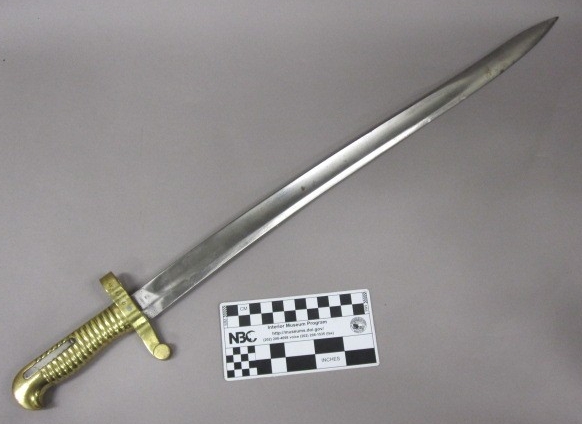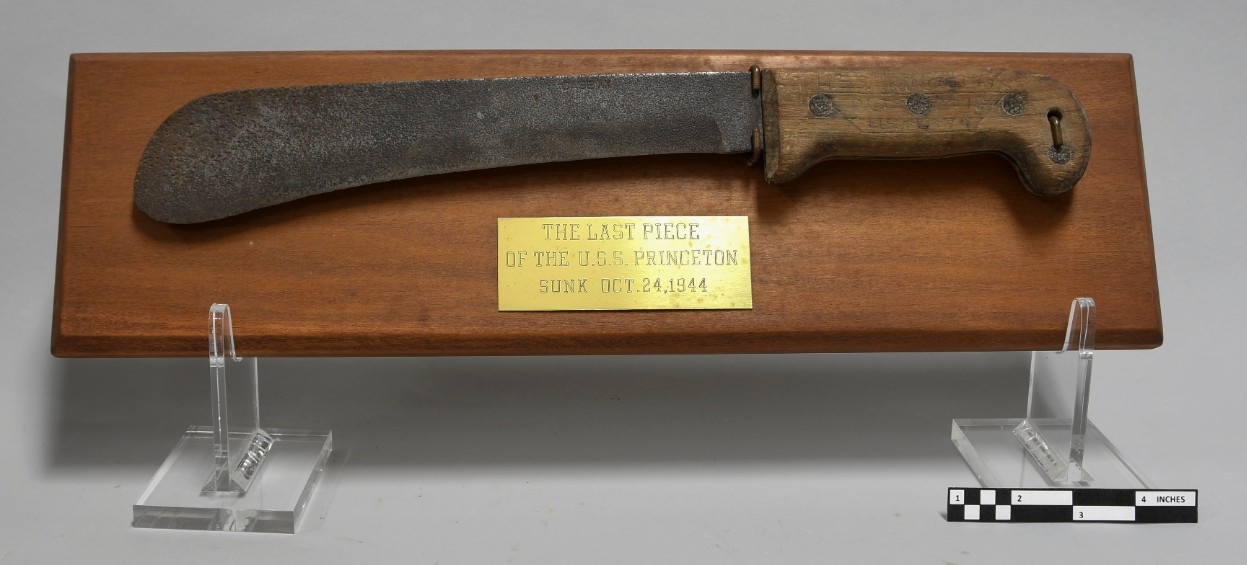- Lt. Thomas H. Stevens’s sword; presented to him by the city of Charleston, SC
- Date: c. 1813
- Description: 34.75 in. Blade with Silver hilt and Ivory Grip. Blade is covered in gilded decorations along with an inscription. Polished Brass Scabbard with decorations.
- Accession # NHHC 1982-65-C
- Location: Headquarters Artifacts Collection, Naval History and Heritage Command
- Caption: This heavily decorated sword was presented to Lt. Thomas H. Stevens for his heroism during the Battle of Lake Erie, commanding the sloop USS Trippe against the British ship Queen Charlotte. The blade is covered in gilded decorations with an inscription that reads: “The Citizens of CHARLESTON to Lieut. THOMAS HOLDUP. He was in the Battle of LAKE ERIE.” In addition, the hilt is made from silver with and ivory grip with a gilt wash, along with an Eagle head pommel (Common in that period.). The guard is made of polished brass and is decorated with a floral design and Lion’s head. The scabbard is polished brass with a gilt wash and is divided into four sections, with decorations representing maritime folklore or American patriotism. This sword’s decorations, inscription, and presentation mark the appreciation that early Americans for those who fought in defense of their freedoms.
- Image: From Navy History & Heritage Command

2. Lt. John Rodgers Presentation Sword
- Date: 1855
- Description: 30 ½ in. steel blade with hand-carved silver hilt. Scabbard: made of wood covered in fabric.
- Accession #: NHHC 1968-737-B, E
- Location: Headquarters Artifacts Collection, Naval History & Heritage Command
- Caption: This sword was presented to Lt. John Rodgers, acting commanding officer of the USS Vincennes and the exploratory expedition in 1855. Rodgers was sailing from Petropavlovsk, Russia to Wrangel Island, but was forced to turn back when the Bering Strait was covered with ice. In October of that year, he had landed in San Francisco, where he was presented this sword by the Russian Consul. The handle was cast in the shape of a Native American battling two panthers. The scabbard has a silver locket and chase and is engraved with a presentation statement and has a stud on the obverse locket in the shape of a bear head. This could possibly represent Pacific Trade relations and alliances between the US and Imperial Russia.
Image: From Navy History & Heritage Command

3. Sharps Rifle Saber Bayonet
- Date: 1861
- Description: 20¼ in. Steel Blade with brass handle & Cross-guard. Stamp of anchor on one side of the ricasso and the company maker on the other.
- Accession #: NHHC 2011-29-45
- Location: Headquarters Artifacts Collection, Naval History & Heritage command.
- Caption: This Saber was an attachable bayonet for a Sharps-style rifle used by the Navy during the 1850s. The stamp of the company shows that it was made by Collins & Co. from Hartford, Connecticut, a civilian tool company. Collins & Co. pivoted to weapons manufacturing with the Civil War looming, contracting with some firearms manufacturers to ensure compatible blades for their new guns. This saber in particular was forged for the US Navy, indicated by the anchor on both the ricasso and cross-guard. Collins & Co.’s pivot to weapons shows the different supply and demands between peacetime and war time, transitioning from farming tools to weaponry to meet said demands.
Image: From Naval Historic & Heritage Command

4. USS Princeton Machete
- Date: 1944
- Description: Rusted single edged blade with brass and wooden handle, mounted on a plaque
- Accession # NHHC 1990-110-A
- Location: Headquarters Artifact Collection, Naval Historic & Heritage Command
- Caption: This machete was from the USS Princeton, which sank on Oct. 24, 1944, in the battle of Leyte Gulf. It was part of a survival kit that Water Tender, 2nd class Sam Tarullo salvaged from a plane. Afterwards, it was gifted to him and mounted it on a plaque before donating it to the NHHC. This machete can tell us what other items were in the survival kit for the Pacific. It also can be used to serve as a reminder of a heroic tale or inspiring hope and courage in others, as many objects in World War II share similar stories.
Image: From Naval Historic & Heritage Command

- Japanese Naval Officer Sword (Kai-Gunto) surrendered by the Japanese to the US Navy
- Date: 1945
- Description: 38 in. metal blade, hilt made with samegawa and silk.
- Accession #: NHHC 1991-25-G
- Location: Headquarters Artifacts Collection, Naval History & Heritage Command.
- Caption: This sword in IJN fittings (Kai-Gunto) was surrendered to Admiral Robert B. Carney by Captain Yoshihiko Takasaki on the USS Nicholas on August 27, 1945. This is the first Japanese sword surrendered to the US Pacific Forces, marking the Japanese defeat and the end of World War II. The hilt is covered with Black Ray skin (Samegawa) and wrapped with brown silk cords, and one is also attached as a tassel and the pommel is decorated with reliefs of cherry blossoms. The Scabbard is like the hilt in its decorations and has two metal hangers, known as Ashi, to place the sword by one’s side.
Image:

